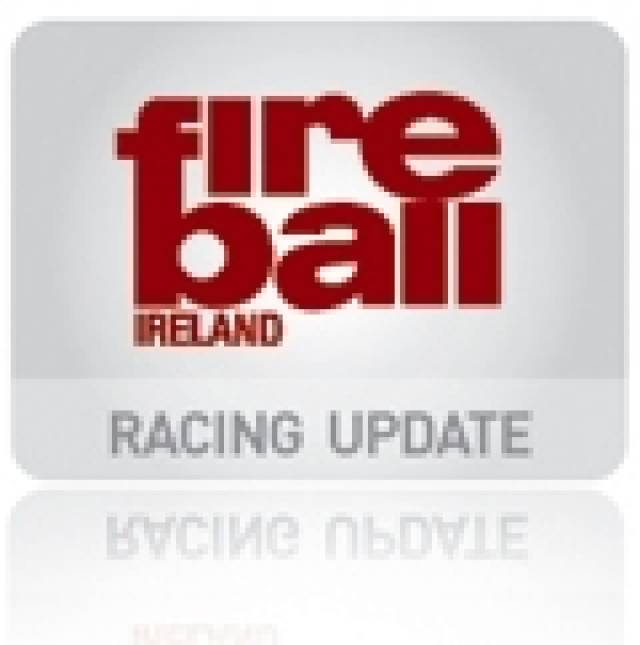#fireball – The 42nd edition of the Frostbite Series got underway in Dun Laoghaire harbour this afternoon, Sunday, 4th November 2012 in grey, blustery and cold conditions writes Cormac Bradley. In contrast to yesterday's sunshine, the skies were full of grey cloud that regularly dumped rain on Dun Laoghaire before the scheduled start. Fortunately, we weren't afflicted by rain on the water, but the grey and the coolness of the air temperature were not alleviated!
In the lead up to the weekend, the suggestion was that the registered entries for the Frostbites were not as good as they have been in recent years – hardly a surprising prospect given the current climate. However, a late flurry of paperwork saw 17 entries on the register for the series and fourteen of those made it to the first start line. Some people took an early bath, before the start, ostensibly to check out a new dry suit but wrapping a spinnaker round the spreader wasn't on the agenda and the damaged sail compromised the performance in the two races – it couldn't be used.
Tim Costello, of Tiamat fame, was the Race Officer for the day and rather surprisingly set a schedule of three laps for the first race. We were soon to find out why!
Sailing before the start, we felt that the breeze was lifting on the starboard tack as one headed towards the east pier. Additionally, on the practice downwind legs, it was apparent that the seas at the harbour entrance were much confused and choppy. Ipso facto – go right on the first beat!
We didn't have the courage of our convictions and found ourselves in a busy stream of Fireballs going left. However, one boat did go right, and they were rewarded by rounding the weather mark first........even though, by their own admission, they were last off the line. Noel Butler & Stephen Oram (IRL 15061) weren't headed throughout the remainder of the race and they recorded the first win of the 2012/13 series. They were chased around the course by Kenny Rumball & Dave Moran (IRL 15058) and the Clancy brothers, Conor and James, sailing IRL 150. Behind this chasing pair were Alistair Court & Gordon Syme (IRL 14706), Frank Miller & Grattan Donnelly (IRL 14713), Neil Colin & Margaret Court (IRL 14775) and Louis Smyth & Cormac Bradley (IRL 15007) who rounded the weather mark in close company. The first reach of the triangle was quite comfortable, but the second reach, in the choppy conditions inside the harbour entrance was a great deal more hairy. Management of these conditions and the subsequent rounding of the leeward mark provided opportunities for place taking. The anchoring of a small raft, just upwind and about 30-40m to starboard of the leeward mark also caused some fun and games.
Different takes on the right-side/left side debate on the upwind course allowed for even more place changing. All the while the lead bunch was sailing away.
The finishing order for Race 1 was Butler/Oram, Rumball/Moran, Clancy/Clancy, Smyth/Bradley, Colin/Casey. However, on shore we found out that Rumball/Moran were scored OCS.
The three laps of Race 1 were then explained........a second race was scheduled! Admittedly, there were only two laps for this one. This time we did have the conviction to go right, though a slow start made that a more attractive prospect than trailing everyone else who had gone left. However, the breeze had also gone left, so the advantage of going right was quite so pronounced. At the first weather mark early running order was Rumball/Moran, Butler/Oram, Luke Malcolm & Shane Divinney (IRL 14790). Court/Syme, Colin/Casey, Miller/Donnelly, Louise McKenna & Hermine O'Keefe (IRL 14691), newcomers 14719, Mike Murphy & son James (IRL 14908), the Clancys and Smyth/Bradley were grouped closely together going round the weather mark. One boat without a spinnaker, another in trouble hoisting and fun & games at the first leeward mark, involving two three Fireballs and a Laser saw place swopping going on before the second and last beat. Bradley Smyth came out best by finding themselves challenging the Clancys and Court/Syme to take the lead slot in the chasing group. At the second weather mark these three were in close company again, with Court/Syme leading from Smyth/Bradley and the Clancys. Court/Syme got too intimate with the gybe mark requiring the taking of turns further down the second reach. This provided Smyth/Bradley the opportunity to get ahead into fourth, a position they held on the short hitch to the finish to just pip the Clancys.
Having assumed that the running order at the front had been maintained, it came as a surprise to read on the results sheet that Malcolm/Divinney had scored the 2nd place, behind Rumball/Moran. It appears that Butler/Oram had a complication with the spinnaker which required a sheet to be untied and retied after sorting. This afforded the young Howth Yacht Club combination the chance to take second which they grabbed with both hands.
|
42nd Frostbite Series, organized by Dun Laoghaire Motor Yacht Club, Sunday 4th November. |
||
|
|
Race 1 |
Race 2 |
|
1 |
Noel Butler & Stephen Oram, DMYC |
Kenny Rumball & David Moran, INSC |
|
2 |
Conor & James Clancy, RStGYC |
Luke Malcolm & Shane Divinney HYC |
|
3 |
Louis Smyth & Cormac Bradley, Coal Harbour |
Noel Butler & Stephen Oram, |
|
4 |
Neil Colin & Margaret Casy, DMYC |
Louis Smyth & Cormac Bradley |
|
5 |
|
Conor & James Clancy |
There were some recognizable sail numbers in new hands on the water today – IRL 14719, previously campaigned by Franko Cassidy and John Hudson has changed hands. "Dogbolter" has been refurbished and was on the water today.
We were also joined on the water by Mike Murphy out of Waterford, sailing with his son, James.
The 42nd Frostbite Series is organised by Dun Laoghaire Motor Yacht Club.

























